
Wildlife Fact Sheet
Kemp’s Ridley Sea Turtle
Lepidochelys kempii
About
Kemp’s ridley sea turtles are the world’s most endangered sea turtle. When in shallow waters, Kemp’s ridley sea turtles dive to the bottom to feed on their favorite food—crabs! Kemp’s ridley sea turtles use their powerful jaws to bite through the crabs’ shells, which otherwise would be difficult to eat. You can recognize Kemp’s ridley sea turtles by their triangular-shaped head, their grayish-green carapace (upper shell) and their pale-yellow plastron (bottom shell).
Weighing in at roughly 100 pounds, Kemp’s ridley sea turtles are one of the smallest sea turtles swimming in the sea. Females nest every one to three years and often travel hundreds of miles to get to just the right location, aiming for the same beach they hatched on! Their biggest threat to survival is human activity. Unfortunately, some humans collect their eggs before they hatch, and juveniles and adults alike are killed for meat and other products. Shrimp trawlers also accidentally pick them up as bycatch when they pull big nets behind their boats, a method known as trawling.
Unfortunately, Kemp’s ridley sea turtles are also greatly impacted by oil spills because their nesting areas in the Gulf overlap with areas that are near major areas of oil drilling. After the BP Deepwater Horizon disaster in 2011, 609 dead sea turtles were found, 481 of which were Kemp’s ridleys.

Did You Know?
Kemp’s ridley sea turtles got their name from the scientist that discovered them, Richard M. Kemp. He first observed them in Florida, and they have been known as Kemp’s ridley ever since. No one knows why “ridley” was added to the name.
Get Ocean Updates in Your Inbox
Sign up with your email and never miss an update.
Status and Conservation
Kemp’s ridley sea turtles spend their days in shallow waters with muddy bottoms, primarily in the Gulf of Mexico. Due to recent oil spills, life has gotten harder for Kemp’s ridley sea turtles. Thankfully, actions are being taken to restore the Gulf region as well as decrease the amount of trash that flows into the ocean! Many fishermen are also using turtle exclusion devices, which help Kemp’s ridley sea turtles not get stuck in fishing nets. All these things will improve their life dramatically and keep their habitat intact.